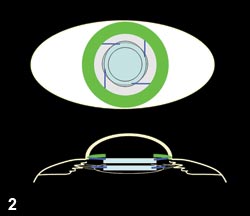Options vary in treating residual refractive errors
Surgical alternatives include LASIK, PRK, piggyback IOL or IOL exchange.
IOL calculations are as much art as they are science because of the difficulty in determining the effective lens position after surgery.
 Uday Devgan |
The effective lens position can vary in eyes that have the same corneal curvature values and axial lengths. An eye with a shallow anterior chamber may have a more anterior effective lens position and therefore the intended IOL power may produce postoperative myopia. In eyes in which it is difficult to determine the true corneal power, such as after myopic LASIK in which the corneal values are underestimated, a postoperative hyperopic surprise can occur. In order to give patients good uncorrected vision, we need to be able to treat residual refractive errors after cataract surgery.

Although there are simple non-surgical options to treat a residual refractive error, such as spectacles or contact lenses, many patients want decreased reliance on glasses and would prefer surgical correction.
Corneal laser vision correction
Performing LASIK or PRK to treat the residual refractive error has the advantage of being highly accurate and able to correct astigmatism, as well as the spherical error. For cases in which significant residual astigmatism is anticipated, I prefer to create a femtosecond laser flap before the intraocular surgery and then to aim for a mildly myopic residual refractive error because myopic ablations tend to be more accurate than mixed ablations. This allows corneal ablation of the residual refractive error a few weeks after the intraocular procedure, once the refraction has stabilized (Figure 1).
 After cataract surgery, the femtosecond flap is lifted and the residual refractive error is treated.  Original IOL in capsular bag. Piggyback IOL in sulcus. Images: Devgan U |
Without preoperative flap creation, I prefer to wait a few months after the intraocular procedure for corneal wound healing before placing a suction ring on the eye for the femtosecond laser or microkeratome. Although the healing is somewhat slower, PRK has the advantage of avoiding flap creation while providing a similar degree of accuracy. Some surgeons prefer incisional techniques to correct residual myopia, such as a two-incision or mini-RK approach. For surgeons without access to an excimer laser, there are other methods of addressing the residual refractive error.
Piggyback IOLs
Placing an additional IOL in the eye is an effective way to correct a residual refractive error, particularly high degrees of hyperopia that are not amenable to corneal laser vision correction. With the original IOL placed in the capsular bag, the piggyback IOL is traditionally placed in the sulcus in a brief procedure that takes just minutes (Figure 2).
Calculating the piggyback IOL power can be done quite accurately with the Holladay vergence formula. It is also easily estimated via a shortcut that I learned from Samuel Masket, MD, which is based upon the patient’s refraction. For myopic refractions, multiply the spherical equivalent by 1.2 to determine the piggyback IOL power. For hyperopic refractions, multiply the spherical equivalent by 1.5 to determine the piggyback IOL power. For example, a +4 D hyperopic residual refractive error would require a piggy back IOL of +6 D (+4 × 1.5) to be neutralized to plano.
It is important to use an appropriate IOL for piggyback placement; these are three-piece IOLs that are made of silicone or collamer material. Certain IOLs are particularly suited just for piggyback sulcus placement, such as the STAAR AQ-5010 because it has a 6.3-mm optic and 14-mm overall length. I avoid placing three-piece acrylic IOLs in the sulcus because they may be more prone to inter-lenticular opacification and iris chafing. Note that single-piece acrylic IOLs should not be placed into the sulcus because they may induce uveitis- glaucoma-hyphema syndrome.
IOL exchange
In cases in which there may not be sufficient room or support for a sulcus IOL, an IOL exchange can be performed. This is a higher risk procedure because it requires careful dissection of the original IOL out of the capsular bag and then replacing it with the new lens implant. If the IOL has been recently implanted, then visco-dissection is usually sufficient to free the lens from the capsular bag. If more time has passed, then more care must be taken to avoid capsular or zonular trauma during IOL explantation.
I prefer to temporarily keep the old IOL in the anterior chamber while I implant the new IOL into the capsular bag. Once the new IOL is implanted in the capsular bag, it protects the posterior capsule from damage when the old IOL is being cut or removed from the eye.
Finally, it is important to learn why the eye had a postoperative refractive surprise and to track back and determine the source of error. This may allow a more accurate calculation for the other eye and prevent a residual refractive error.
For more information:
- Uday Devgan, MD, FACS, is in private practice at Devgan Eye Surgery in Los Angeles, Beverly Hills, and Newport Beach, California. Dr. Devgan is Chief of Ophthalmology at Olive View UCLA Medical Center and an Associate Clinical Professor at the Jules Stein Eye Institute at the UCLA School of Medicine. Dr. Devgan can be reached at 11600 Wilshire Blvd., Suite 200, Los Angeles, CA 90025; 800-337-1969; fax: 310-388-3028; e-mail: devgan@gmail.com; Web site: www.DevganEye.com. Dr.Devgan is a consultant to Abbott Medical Optics and Bausch & Lomb, and is a stockholder in Alcon Laboratories and formerly in Advanced Medical Optics.
Reference:
- Jin GJ, Merkley KH, Crandall AS, Jones YJ. Laser in situ keratomileusis versus lens-based surgery for correcting residual refractive error after cataract surgery. J Cataract Refract Surg. 2008;34(4):562-569.
